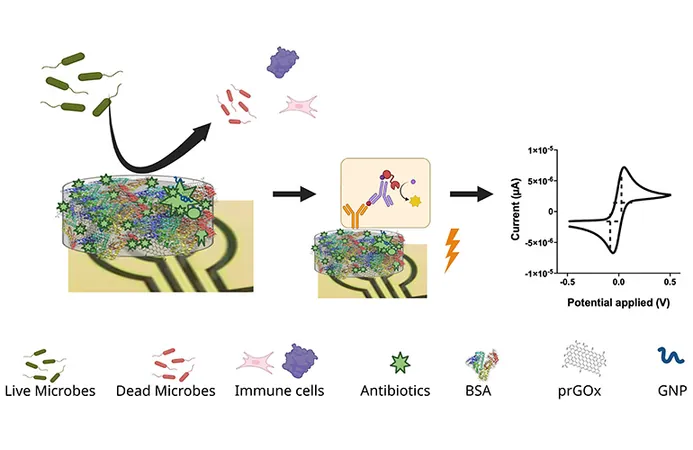
Groundbreaking Coating Technology Transforms Biosensors: A New Era in Medical Monitoring Awaits!
2025-03-28
Author: Jia
Researchers at Harvard University’s Wyss Institute for Biologically Inspired Engineering have made a monumental breakthrough by developing an innovative coating technology aimed at revolutionizing the longevity of implantable and wearable biosensors. This advancement is set to change the landscape of disease monitoring, allowing for real-time tracking of biomarkers associated with various health conditions.
The newly engineered coating combines a cross-linked matrix of bovine serum albumin (BSA) and functionalized graphene. This dual action not only combats biofouling—the unwanted buildup of biological material around sensors—but also minimizes immune responses that threaten the operational lifespan of these devices. In a groundbreaking proof-of-concept study, the team showcased how sensors coated with this promising technology remained functional for over three weeks while accurately detecting significant inflammatory biomarkers, as detailed in their findings published in the esteemed journal Biosensors.
Dr. Donald Ingber, the Founding Director of the Wyss Institute and leader of the study, expressed his excitement: “This novel coating technology addresses a significant barrier in developing the next generation of electrochemical in vivo sensors. In an era emphasizing personalized medicine and digital health, this opens a wide array of diagnostic and research applications.”
Tackling Two Major Challenges: Biofouling and Immune Response
Biosensors have already made monumental strides in managing chronic illnesses by facilitating continuous monitoring of physiological signals—like glucose levels or inflammatory markers. Yet, their performance often falters due to biofouling, which involves the accumulation of bacteria and cells that disrupt sensor operation. Additionally, when implanted, these sensors can provoke an immune response, leading to fibrotic tissue build-up and diminishing their efficacy.
The Wyss team has crafted a unique solution. Their BSA lattice serves as a natural barrier, effectively preventing contamination and non-specific binding, while the functionalized graphene component ensures optimal electrical signaling. This innovative coating not only protects against external contaminants but also integrates analyte-detecting antibodies and antibiotics to fight biofouling actively.
During testing, the electrochemical sensors adorned with this advanced coating successfully detected two critical inflammatory biomarkers while remaining fully operational over a period of three weeks in complex human plasma. Remarkably, the coating resisted biofilm formation from Pseudomonas aeruginosa, a notoriously resilient bacterium known for creating antibiotic-resistant biofilms on medical devices. It also inhibited fibroblast adhesion and curtailed immune cell activation, which is pivotal for sensor performance.
What This Means for the Future of Medical Monitoring
The practical implications of this research are vast. The Wyss Institute's advancements could significantly prolong the operational lifespan and reliability of biosensors used in clinical settings. This extended functionality promises to enable prolonged monitoring of patients suffering from chronic and autoimmune diseases and enhances the evaluation of therapeutic responses during clinical trials.
Moreover, the team has developed this coating with scalability in mind, making it a cost-effective option for future sensor production. The materials are readily accessible, and the fabrication process can be adapted for large-scale production, paving the way for widespread adoption in the medical community. With patented technology and an eye toward collaborating with industry partners, the Wyss Institute is eager to propel this cutting-edge development into practical application.
In summary, as researchers at Wyss Institute continue to push the boundaries of biosensor technology, the prospects for more effective, long-lasting medical devices are not just hopeful—they are on the brink of becoming a reality. Keep an eye on this space, as the future of health monitoring may soon be transformed into a more personalized and efficient experience for patients worldwide!

 Brasil (PT)
Brasil (PT)
 Canada (EN)
Canada (EN)
 Chile (ES)
Chile (ES)
 Česko (CS)
Česko (CS)
 대한민국 (KO)
대한민국 (KO)
 España (ES)
España (ES)
 France (FR)
France (FR)
 Hong Kong (EN)
Hong Kong (EN)
 Italia (IT)
Italia (IT)
 日本 (JA)
日本 (JA)
 Magyarország (HU)
Magyarország (HU)
 Norge (NO)
Norge (NO)
 Polska (PL)
Polska (PL)
 Schweiz (DE)
Schweiz (DE)
 Singapore (EN)
Singapore (EN)
 Sverige (SV)
Sverige (SV)
 Suomi (FI)
Suomi (FI)
 Türkiye (TR)
Türkiye (TR)
 الإمارات العربية المتحدة (AR)
الإمارات العربية المتحدة (AR)